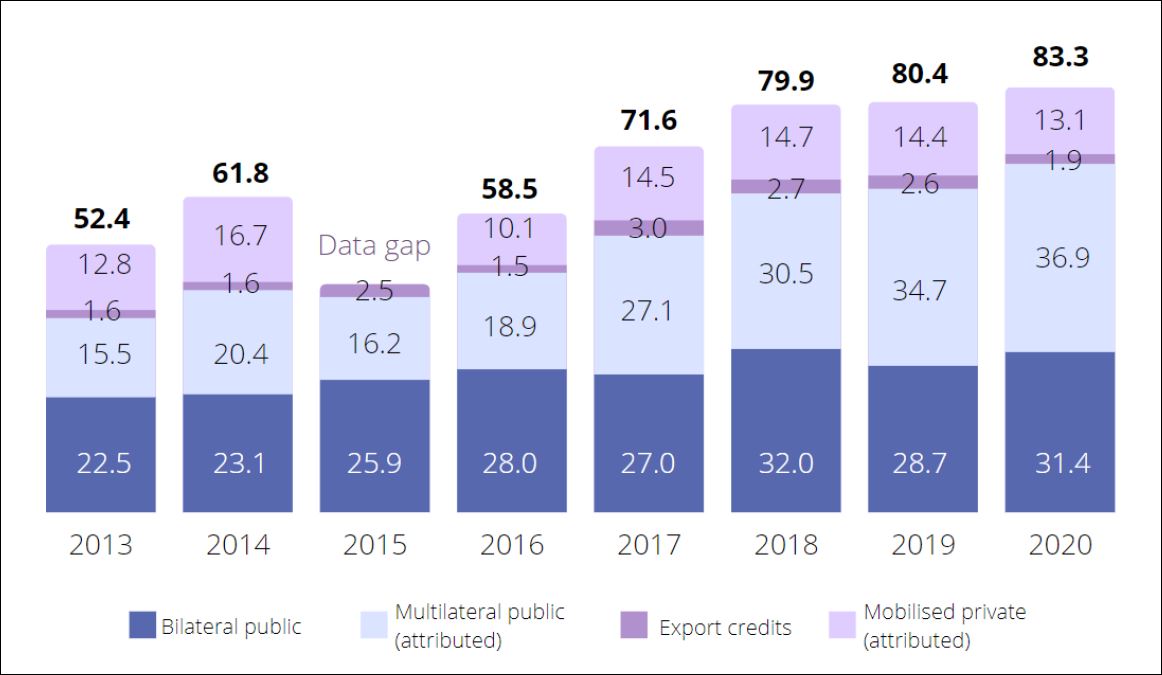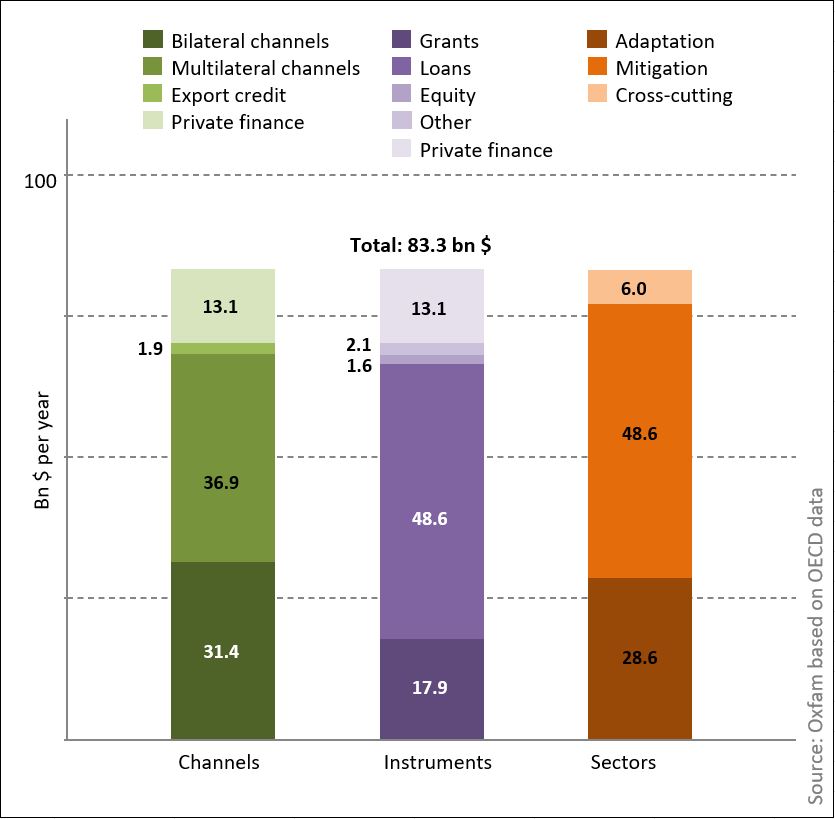100 billion / Pledges & Commitments / UNFCCC
OECD confirms: Rich countries broke the $100-billion promise
As expected, developed countries did not keep their promise from 2009 to ramp up climate-related financial assistance to $100 billion a year by 2020. The OECD now reports that in 2020, a level of around $83 billion had been reached.
The goal by rich countries to ramp up support to cut emissions and adapt to a changing climate in developing countries to $100 billion a year by 2020 was among the few outcomes of the otherwise disastrous 2009 UN climate summit in Copenhagen. Over time, climate finance and the $100-billion promise have become an integral part of the international climate regime. Six years later, at the 2015 UN climate summit that adopted the Paris Agreement, rich countries not only confirmed the goal but also agreed to keep the level of $100 billion a year through to 2025.
Climate finance did increase since 2009, and, if looking at the frontline numbers, sizably so. At the same time, early signals emerged indicating that keeping the promise might become difficult given the lack of ambition demonstrated by developed countries to increase assistance from their public budgets, coupled with unrealistic scenarios how much private investments developed countries would be able to mobilise.
In the run up to last year’s UN climate talks COP26, developed countries finally accepted that reality and set out 2023 as the new target year when the level of $100 billion a year would be reached – based on a string of pledges by developed countries for the 2021-2025 period, including the €6-billion pledge by Germany (that the Federal Government seems to largely ignore so far).
OECD: Rich countries fell short $17 billion in 2020
Now, in its recent report, the OECD confirms what everybody expected: climate finance in 2020 fell far short below the promise, reaching around $83 billion, significantly lower than the promised $100 billion and only marginally higher than the levels achieved in 2019 and 2018 (around $80 billion each).
Figure 1: Climate finance 2013-2020 (in bn USD)

Climate finance 2013-2020 as per the most recent OECD report. As can be seen, while climate finance grew over time, in recent years the overall volumes almost levelled off. Developed countries are now officially in breach of their $100-billion promise from 2009. Source: OECD.
This is not only a political disaster for the credibility of rich countries with repercussions expected for the upcoming UN climate talks COP27. It also has real-life consequences for people already suffering from the worsening climate crisis as billions of dollars do not get spent on crucial programmes and projects to lower emissions and make communities in developing countries more resilient to the changing climate.
And even if $83 billion may look like a big number (though compare it to the fiscal measures developed countries put in place to help their economies recover from the Corona pandemic; the total value would allow to meet the $100-billion goal for the next 150 years, see table here), there are several problems attached to it when taking a closer look.
Figure 2: 2020 climate finance, by channels, instruments & sectors (in bn USD)

Climate finance in 2020, broken down by channels for providing finance, instruments offered and sectors benefitting from climate finance in 2020, as per OECD data.
|
Generous accounting, worsening debt and disregard for adaptation
First off, the number does not correspond to the actual support provided to developing countries. It is a gross figure that developed countries have reported – in a system that allows generous accounting for programmes where climate considerations may only be a minor component, and where loans are counted at face value even though they will be repaid, with the actual financial benefit for the recipient country being limited to the favourable terms and lower interest of a concessional loan compared to a loan at market rates, not the loan as such. In its 2020 Climate Finance Shadow Report, Oxfam estimated that the net financial support specifically targeting climate action in developing countries may have been only around a third of what developed countries reported as public climate finance in 2017 and 2018. This will most likely have been similar for 2020.
Loans are not only a problem of accounting. 71% of public climate finance in 2020 came in the form of loans, many of them not even concessional but at market rates. This is deeply unjust, as vulnerable countries should not be forced to take on loans to deal with a crisis they did not cause, putting climate justice on its head. Climate also loans add to the problem of mounting debt in poorer countries that already have very little fiscal space not least because of the worsening climate crisis but also other crisis, including the Corona pandemic or the fallout from the war in Ukraine.
And, only about a third of all climate finance in 2020 was allocated to adaptation to make developing countries more resilient. To be sure, the 2020 figures show an improvement over previous years where the share for adaptation was even lower. Yet, this is far from achieving the agreed balance between mitigation and adaptation, which should eventually lead to a 50:50 split between mitigation and adaptation when allocating climate finance.
Ball now in the developed countries’ court
It stands to be hoped that developed countries will now take serious steps to improve the situation – and send out relevant signals well ahead of the next UN climate talks COP27. This would mean gradually increasing climate finance so that the promised level of $100 billion a year over 2020-2025 (i.e. $600 billion in total) is achieved, including compensating for shortfalls in earlier years through higher support in subsequent years. Also, such increases should happen by significantly increasing support for adaptation, to at least reach the goal set by COP26 to double adaptation finance by 2025 (from 2019 levels) en route to a true balance of 50:50. Any such increases should come in the form of increased provision of grants, to ensure recipient countries do not have to take on more debt.
Jan Kowalzig, Oxfam




